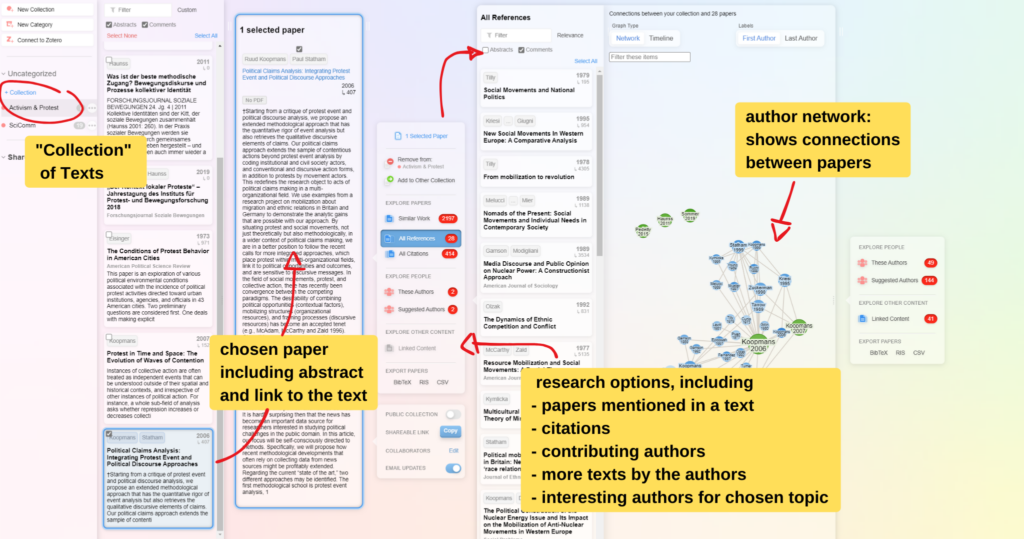With the "Deus Ex Machina? — Testing AI Tools"-series we want to show you different tools, that aim to simplify writing, design and research by using Artificial Intelligence. More on the "Deus Ex Machina?"-series can be found here.
Overview
"Reimagine Research" is what the ResearchRabbit homepage declares as their motto. As the name suggests, it is a tool for scientific research that is intended to make the search for suitable sources and scientific input more intuitive and to simplify the discovery of relevant papers. The developers call ResearchRabbit a "Spotify for Papers", which, with regular use, is supposed to get to know the search criteria of its users and thus optimize its suggestions.
To use ResearchRabbit, users start with a "seed paper", i.e., a scientific text that is marked as the beginning of the search. Starting from this, the programme suggests further, matching scientific texts. These texts can be linked to each other either by comparable subject areas, authors or citations, so that the texts suggested by ResearchRabbit complement an already existing text "collection" (collection of papers on a topic).
Texts that have been assembled into a collection can be examined more closely in a second step: in addition to the authors, the publication date and medium, ResearchRabbit shows an abstract and how often the displayed paper has been cited in other scientific works. This is one of the strengths of the tool: with just a few clicks, you can find out who has been cited, who the authors are and in what context these citations occur. The side-by-side listing of research paths (which can theoretically be continued ad infinitum) makes it easy to trace the search process even in retrospect and, if necessary, to adjust it again in the middle of the path.

But its not only the citations that can be tracked via ResearchRabbit; the tool can also be used to track which texts the authors of the "seed papers" refer to via the "All References" button. Under "These Authors", users can take a closer look at the authors of the texts and, for example, search for frequent collaborative relationships among authors or view which works were published before or after the selected text.
ResearchRabbit displays these connections between the different authors in a network cluster ("author networks") with connecting lines between authors linked by their research work. It even visualises how often authors have collaborated: the thicker the grey connecting line between them, the more joint papers ResearchRabbit has found. This also makes it possible to see which authors are or were particularly influential in their field.
However, ResearchRabbit only displays the texts that it finds by itself with its search algorithms. Therefore, one should not assume that the search results presented are complete. Likewise, not every text is read out completely, so some connections between texts only emerge when you read through them yourself.
The AI behind the application
The algorithms on which the ResearchRabbit AI is based have not yet been published, neither have the data on which they were trained upon. Even when asked, the ResearchRabbit team did not provide an answer. The FAQs point out that ResearchRabbit's search engine uses the search algorithms of the NIH (National Institute of Health, USA) as well as the NIH-based services PubMed.gov and the National Library of Medicine, as well as those of Semantic Scholar, and thus generates suggestions for papers.
ResearchRabbit's own algorithm is trained to make suggestions for the texts selected by the users, to extract the relevant metadata from these and to make further text suggestions. These are divided into three categories: Similar Work, Earlier Work and Later Work. Earlier and Later Work refer to the citation relationships between individual texts; according to ResearchRabbit, temporal data (publication date) is also read out here to generate an overview for the user. "Similar Work", on the other hand, is detached from this and, according to the FAQs, is not congruent with Earlier and Later Work, but refers more to other relationships between the texts, for example the citation networks. According to its own information, ResearchRabbit initially loads only the 50 most relevant texts to a search query in order to keep the research as focused as possible.
Incidentally, ResearchRabbit takes its name from the idea of diving deeper and deeper into the next research "rabbit hole" (a reference to Alice's journey down the rabbit hole in Lewis Carol's "Alice in Wonderland") with the help of the research flow that the tool's design is supposed to promote.
The rhetorical potential of the tool
In the research phase, ResearchRabbit is a support in finding suitable texts and interesting references for one's own academic work. In particular, the "works cited" function and the author network can give an indication of which texts are relevant in the field being researched and have generated a corresponding echo. Nevertheless, the quality of the texts and their relevance to one's own topic must be checked manually, since the program does not provide any assessments of the quality of the texts. Furthermore, users can add comments to the texts themselves, but not view the comments of other users.
The same rule of thumb applies to this tool that should also apply to others: if possible, one should start using the tool with prior knowledge of a topic and a manual search that has already been carried out. On the one hand, this is because it is much easier to recognize texts that are relevant to one's own work and to separate them from papers that cannot be used, and because researchers relevant to one's own work can be found more quickly via the author networks. Otherwise, users may quickly be overwhelmed by the amount of options.
Usage in science communication
ResearchRabbit is aimed at researchers, scientists, students in higher semesters and other people with a scientific background. Important for the successful use of ResearchRabbit are previous knowledge in the researched field and a reflection in advance on the results ResearchRabbit should deliver in order to keep the search time for suitable literature as short as possible.
For each scientific text, ResearchRabbit provides an abstract including citation and a link to the respective text: either as a PDF or by forwarding to JSTOR, Springer Link and other portals. For those who do not have access to these portals via their own university or research institution, ResearchRabbit will only be of limited use, as the programme may be able to find many texts, but can only output them directly in rare instances where a PDF is stored in ResearchRabbit itself or the text sought has been published open access.
Prior knowledge also helps the user to feed the "Rabbit" with meaningful initial texts that determine the orientation of the literature it suggests for the "Collaboration" (text collection). At the time of writing, all that is required to use ResearchRabbit is an account on the site; the service is free for researchers and, according to the FAQ, is supposed to remain free in the future.
Finally, ResearchRabbit offers the option to network with others on the platform and create joint text collections. This opens up the possibility to conduct research together for a joint project. Ones own collections can be shared with other people and groups for 14 days even if they do not have their own ResearchRabbit account. In this case, however, they can only view the collections, not edit them themselves.
And finally, the "Linked Content" function allows users to see where texts from their own collection are also used in non-academic contexts — for example, on Wikipedia, personal blogs or official websites of practice centres. However, the information in ResearchRabbit itself is not yet very sophisticated. In addition to the chosen text, in many cases only the type of website on which the text was used or named (WordPress, for example) is displayed, but not the institution to which the respective website belongs.
Wrap-Up
The name ResearchRabbit and the metaphorical journey down the scientific rabbit hole is spot on with this tool. The intuitive handling of "dipping further and further into the rabbit hole" is facilitated by the fact that information that might be of interest to researchers, such as previous works or authors cited in a paper, is directly accessible with just a few clicks.
However, even ResearchRabbit is not free of errors — until the "seed paper" has programmed the algorithm to its own interests, a lot of input has to be given. And not every text searched for can be found by ResearchRabbit or is returned by the tool as the first search result, or even as a search result at all — even with a very precise keyword search including title(s), name of the author(s) and publication date. If you keep these points in mind and also use the conventional library catalogues and other search masks, ResearchRabbit can be a valuable help in research work and in presenting text and author contexts.





